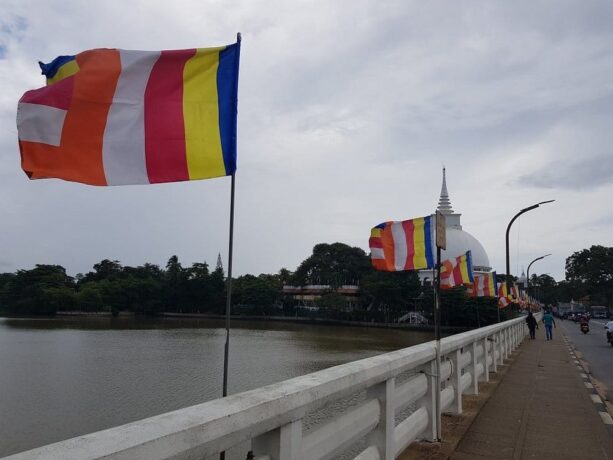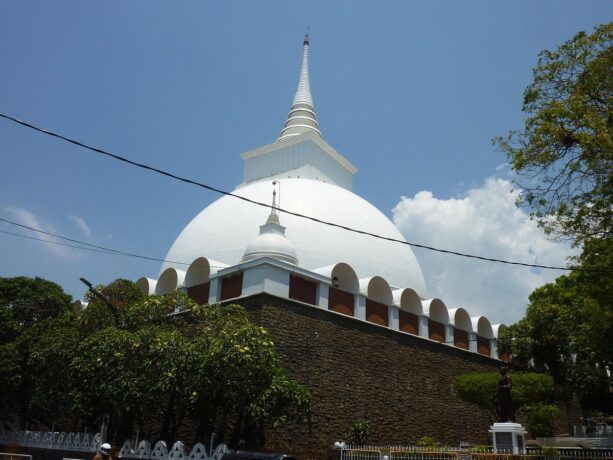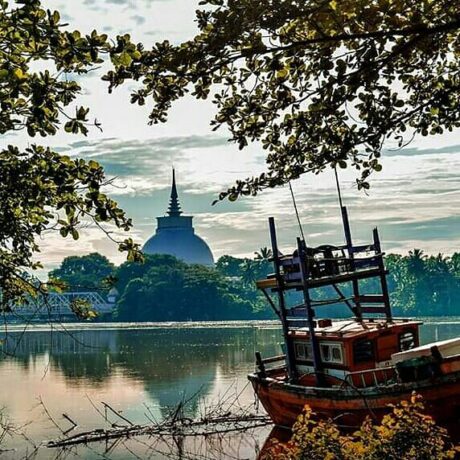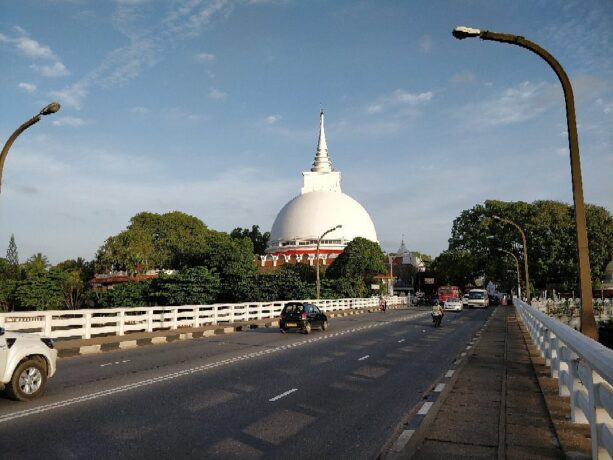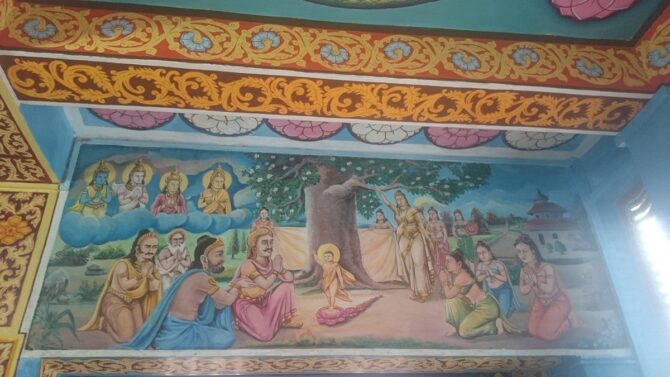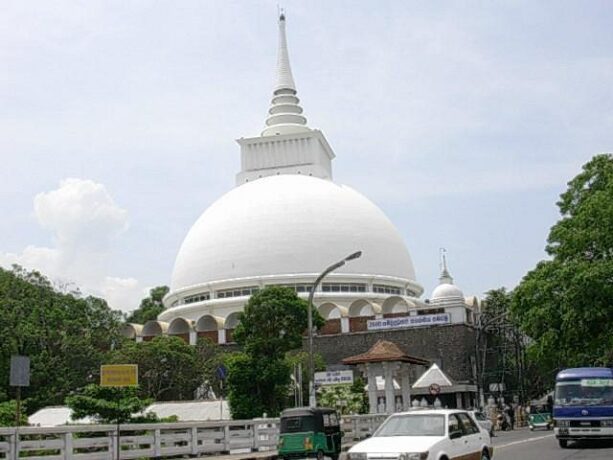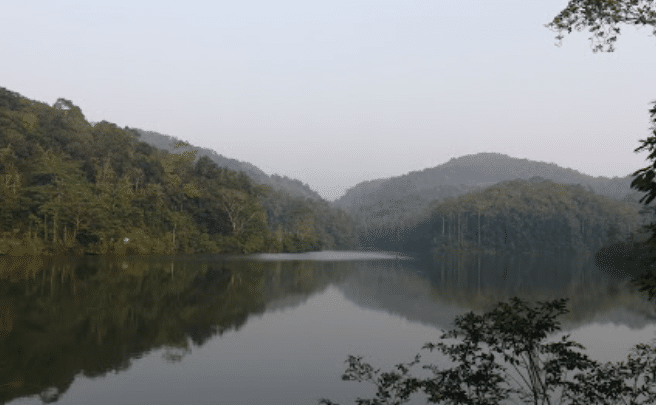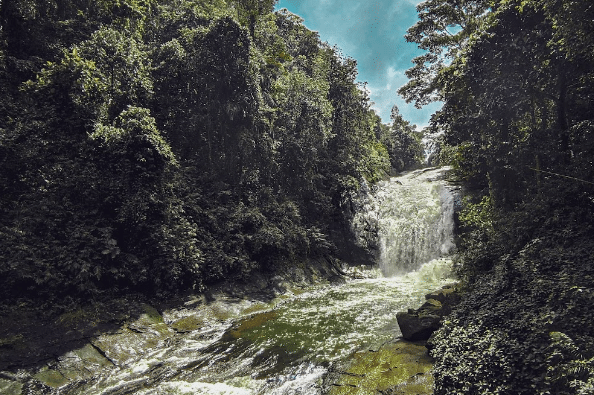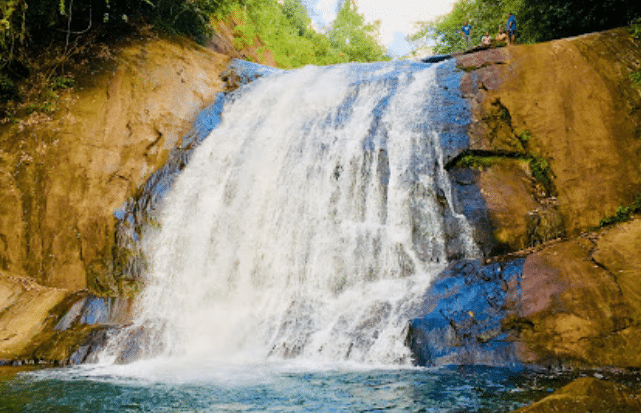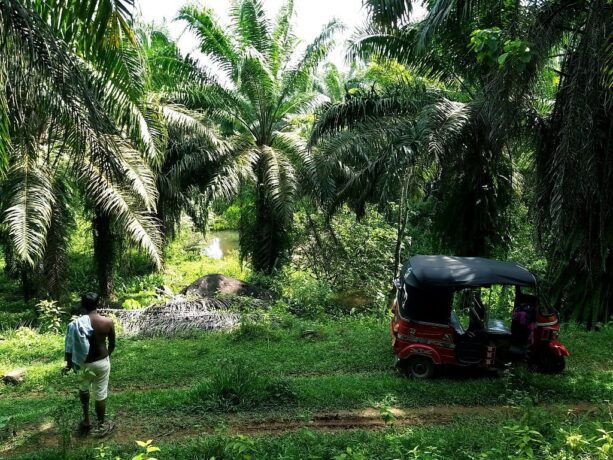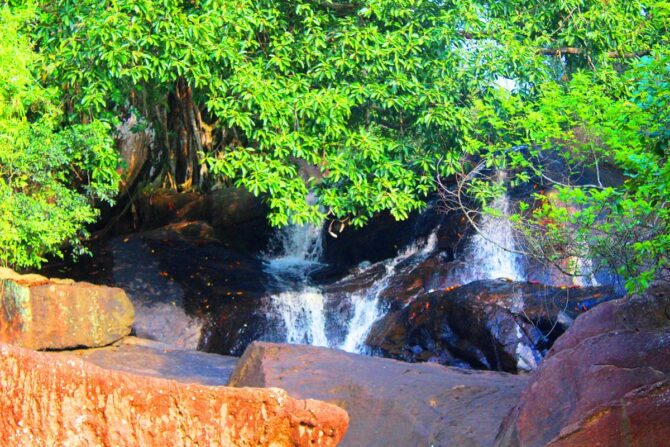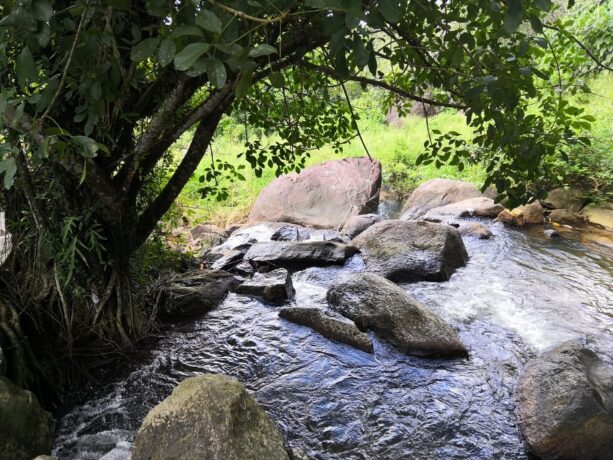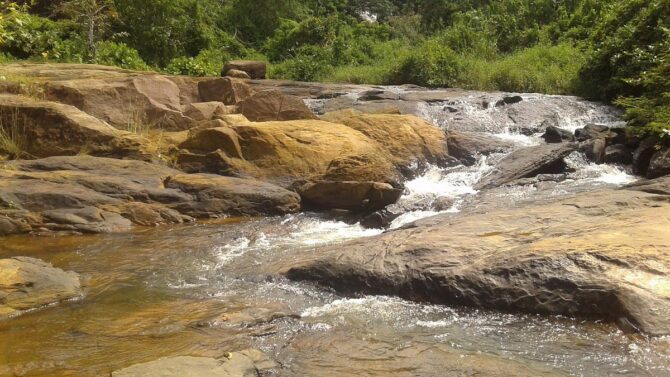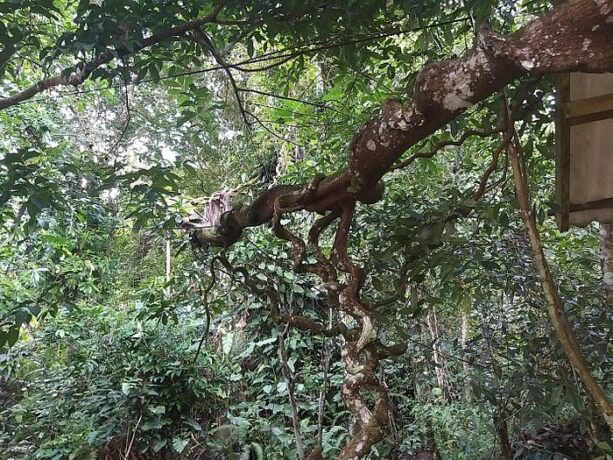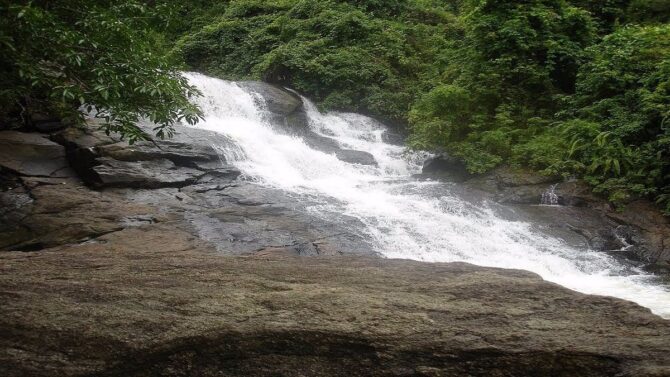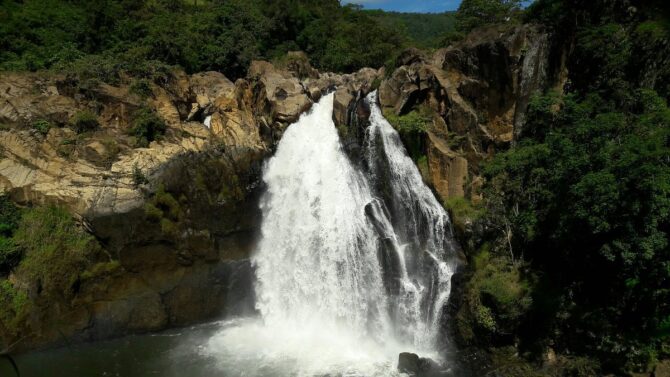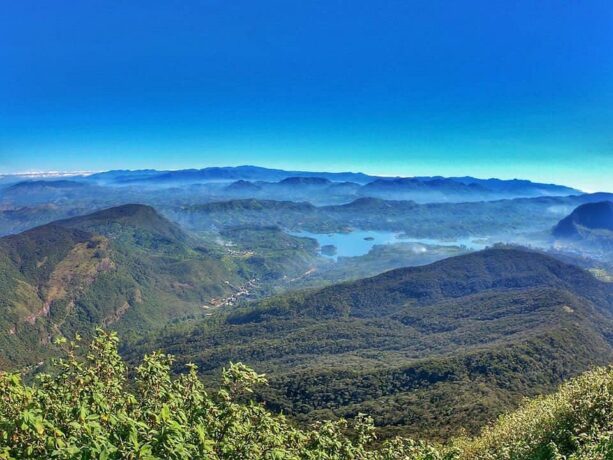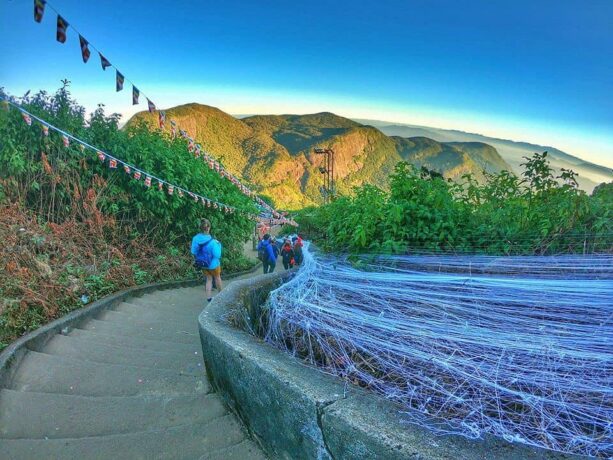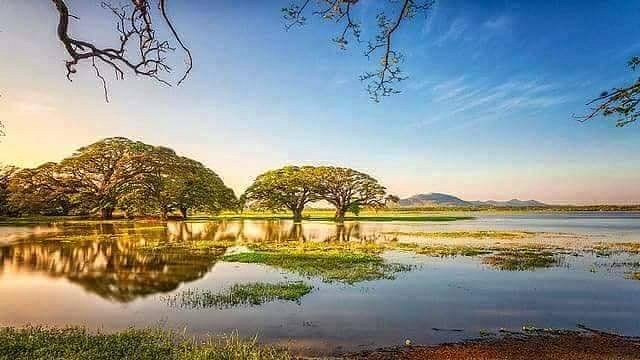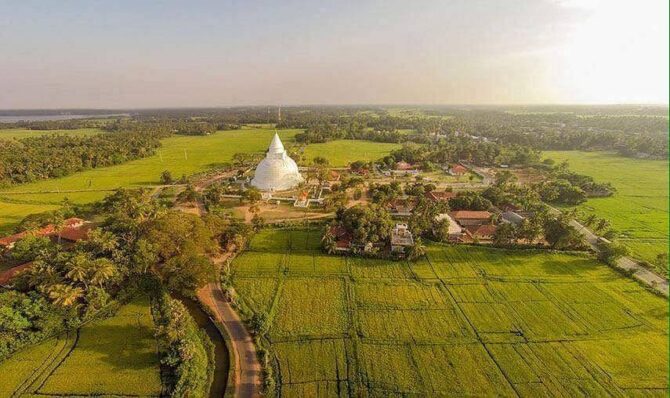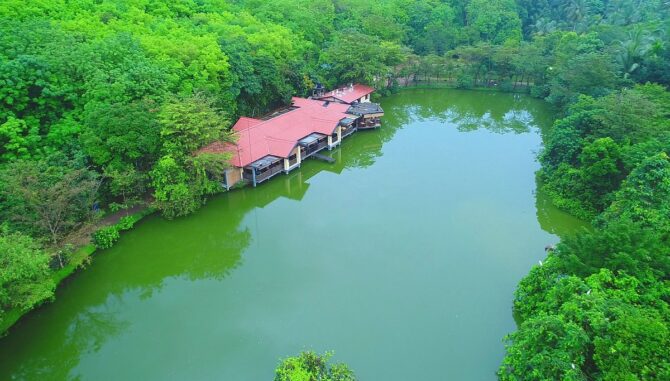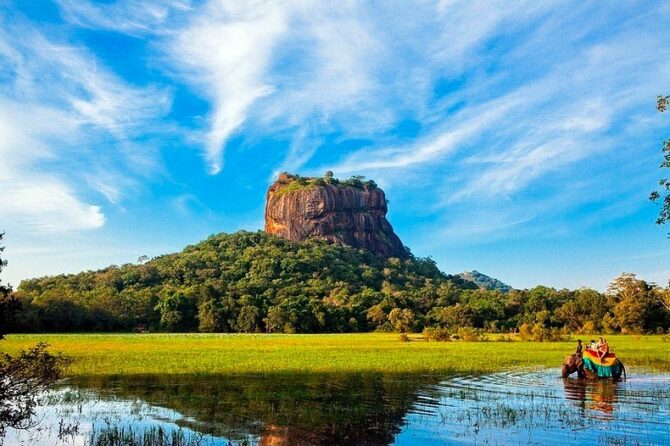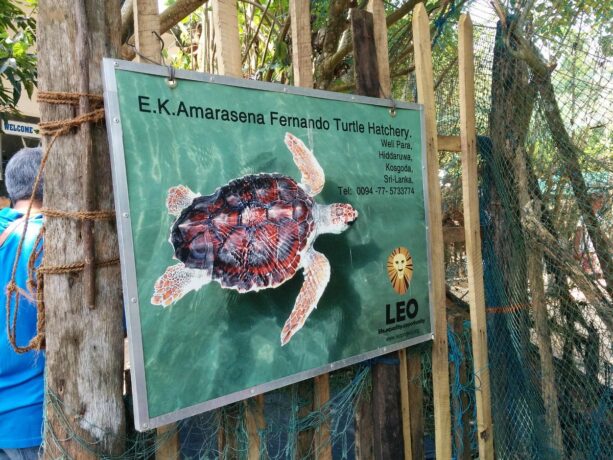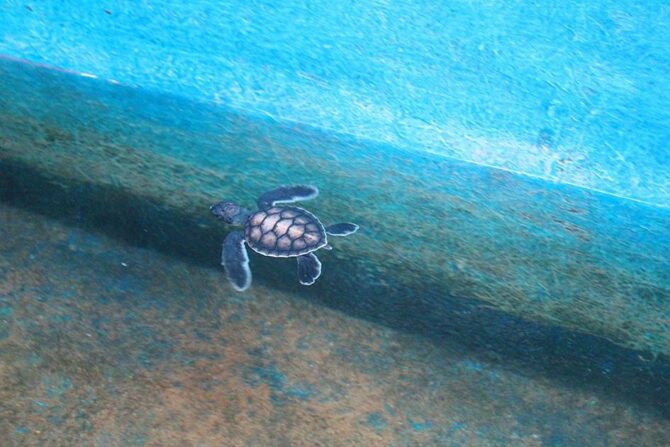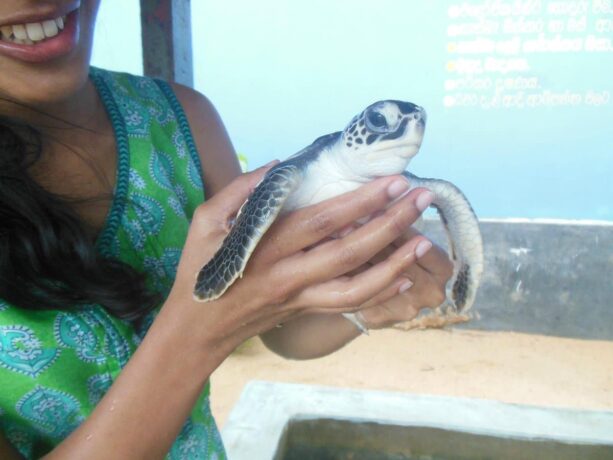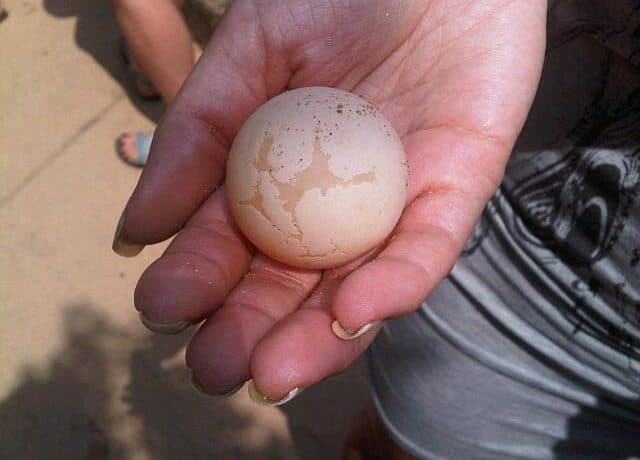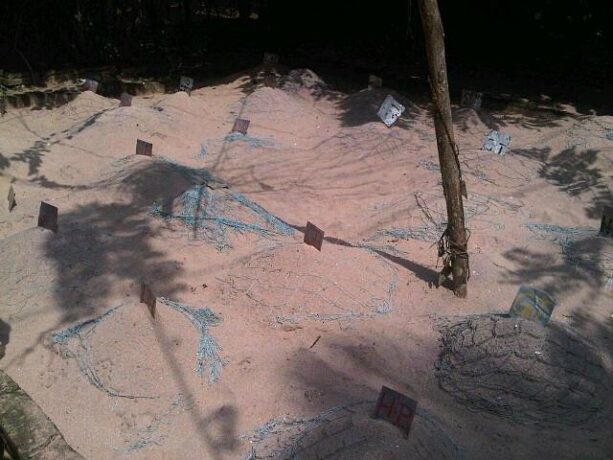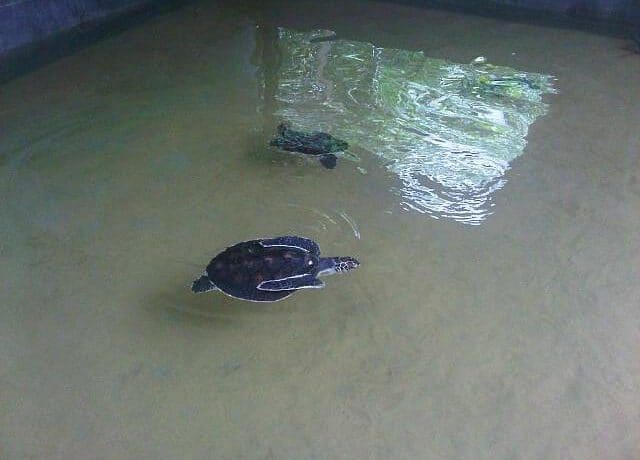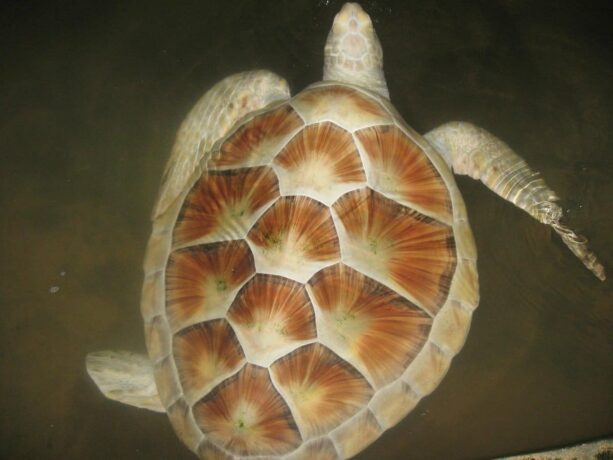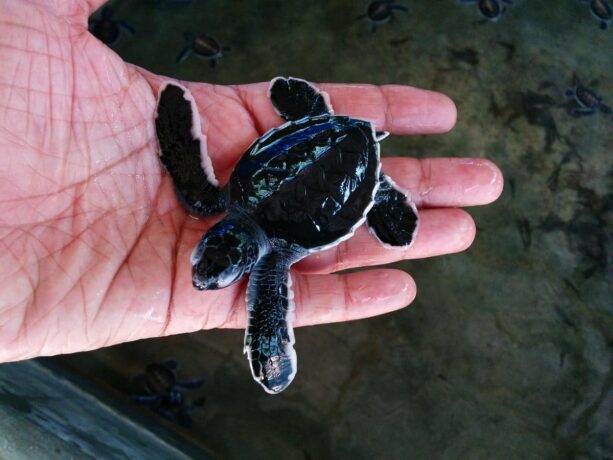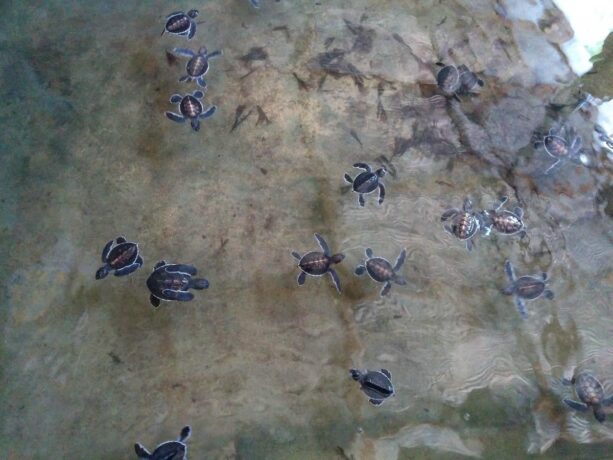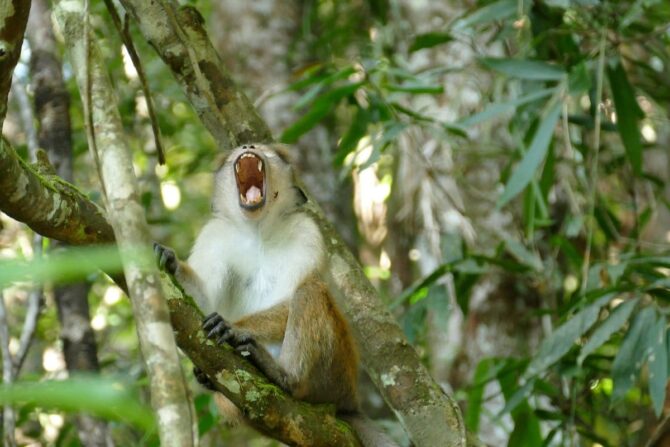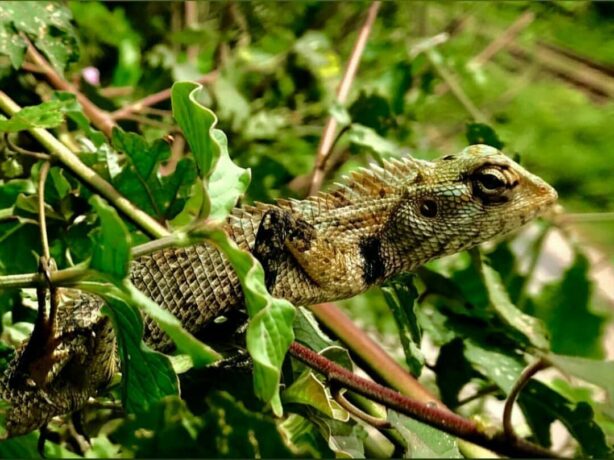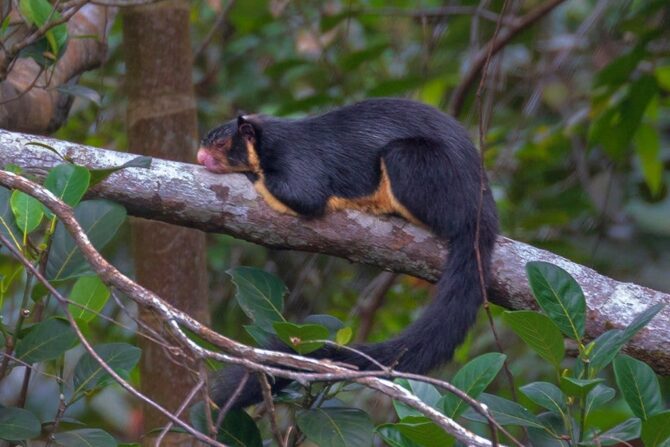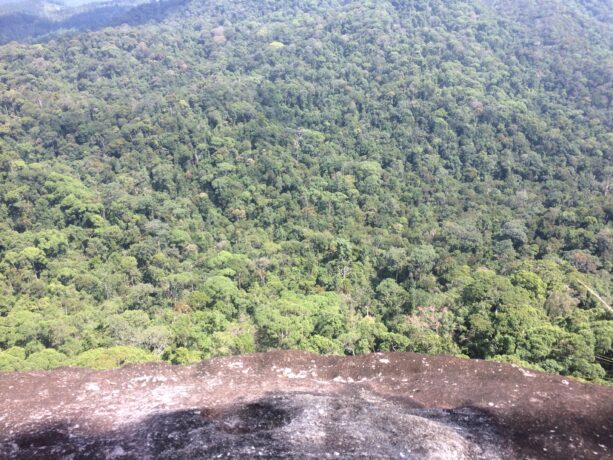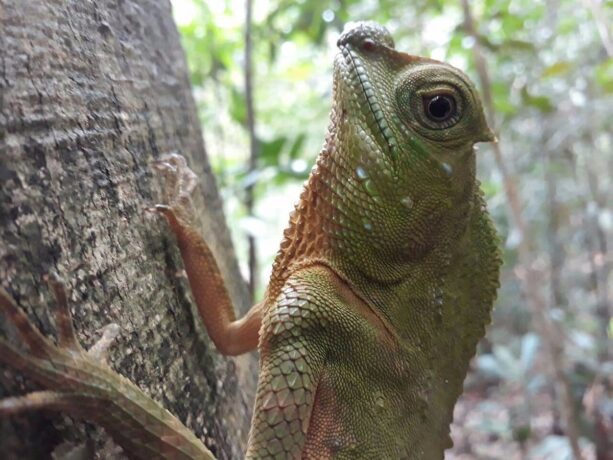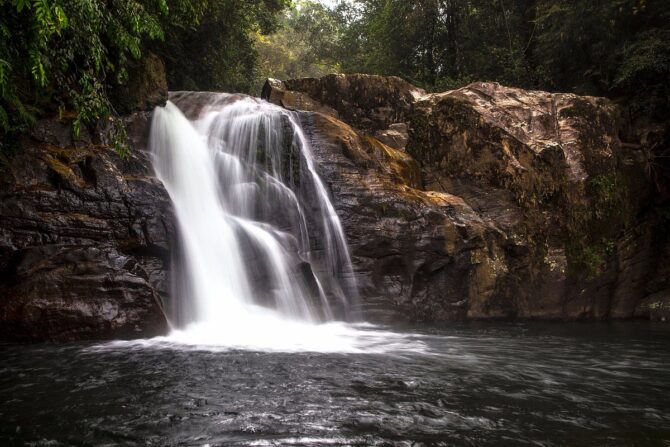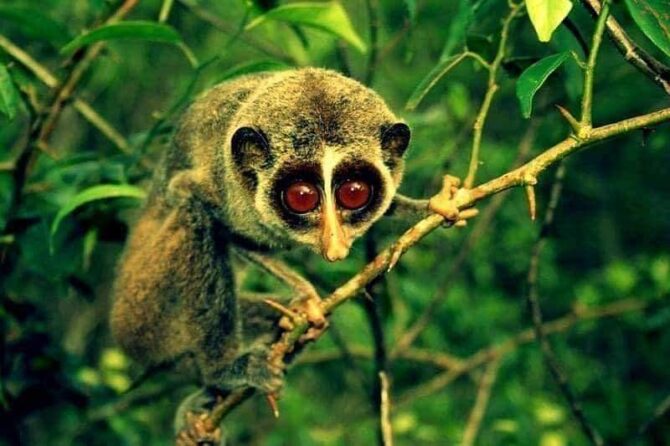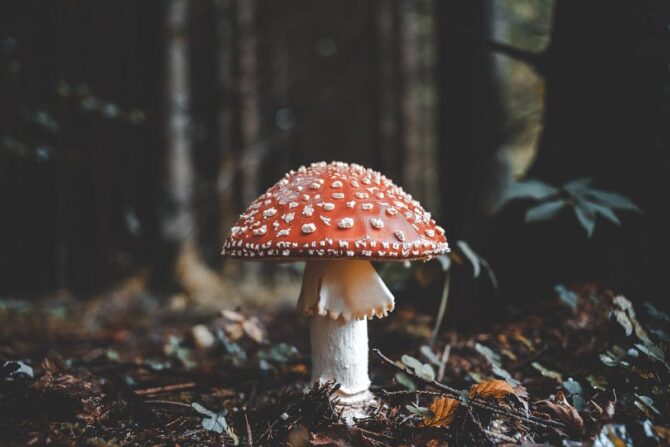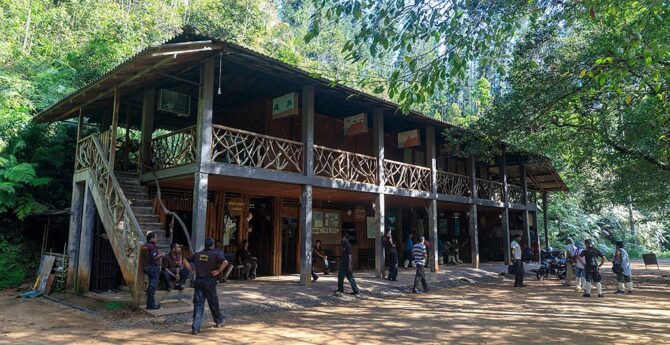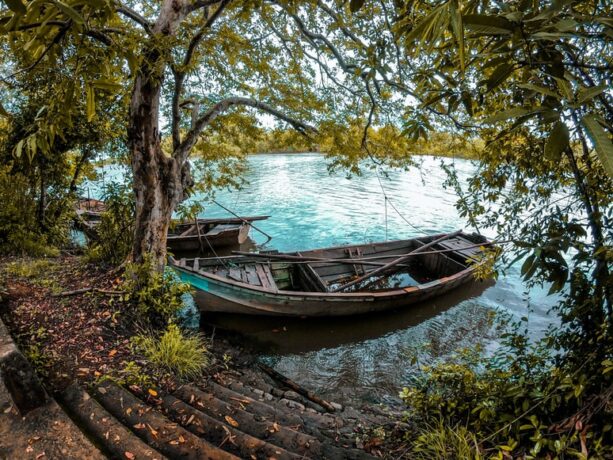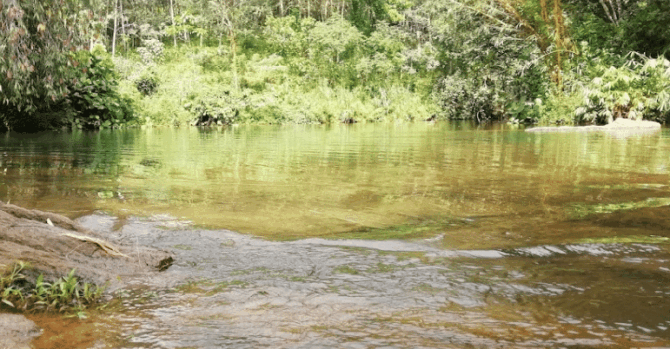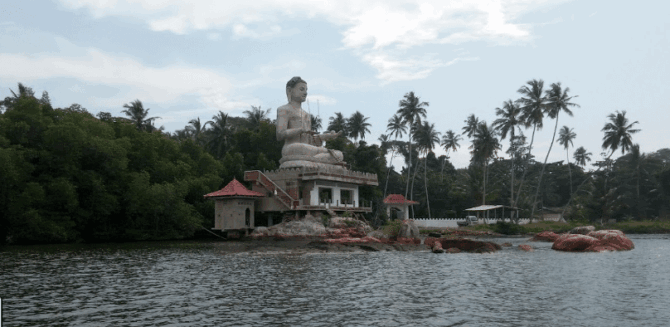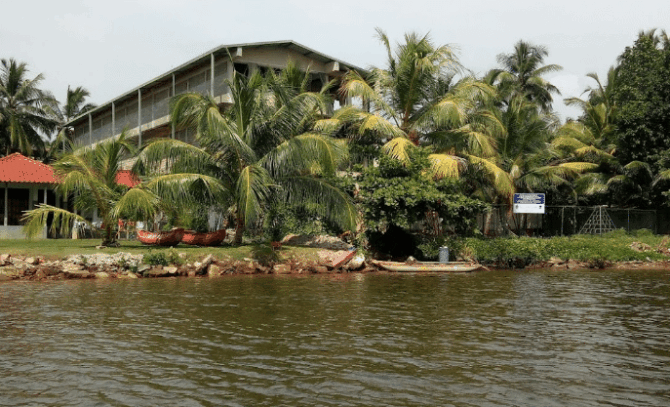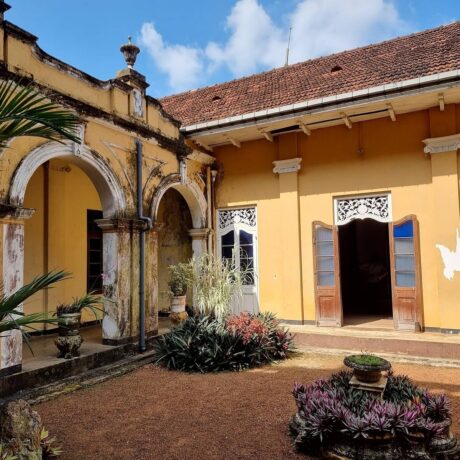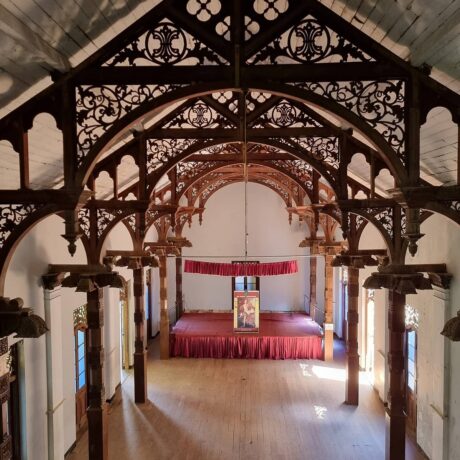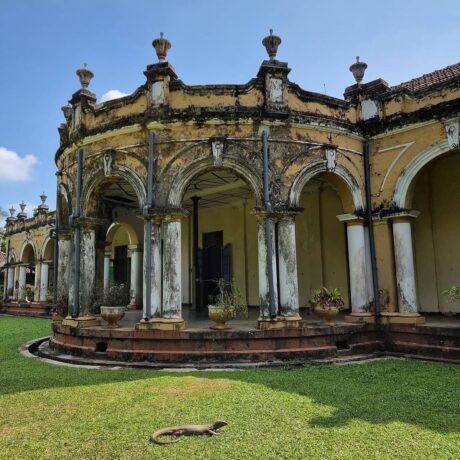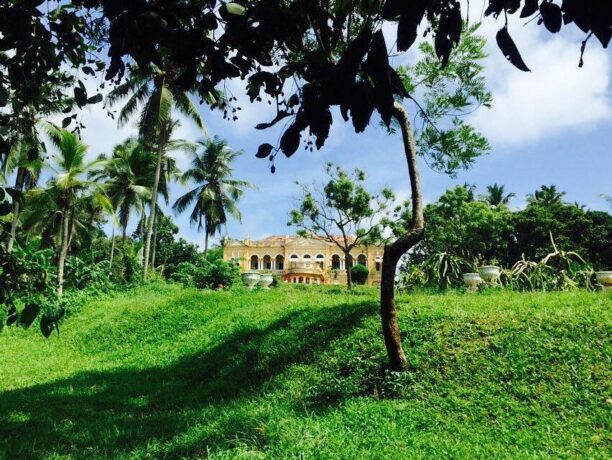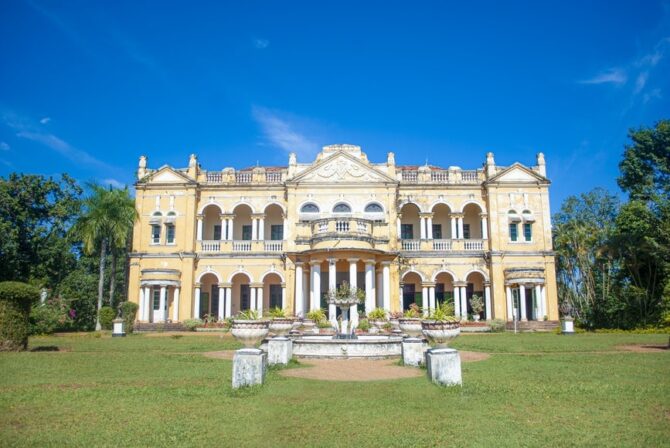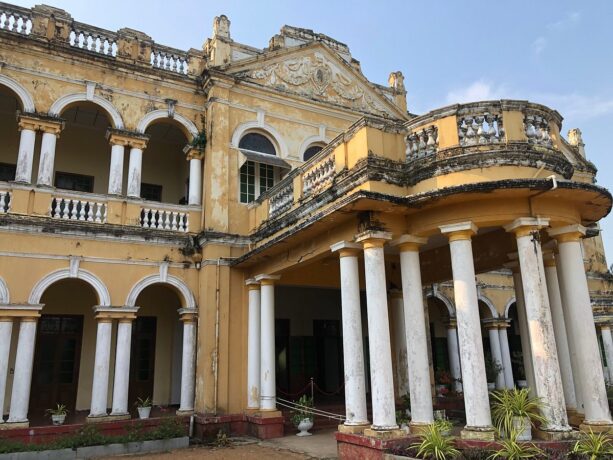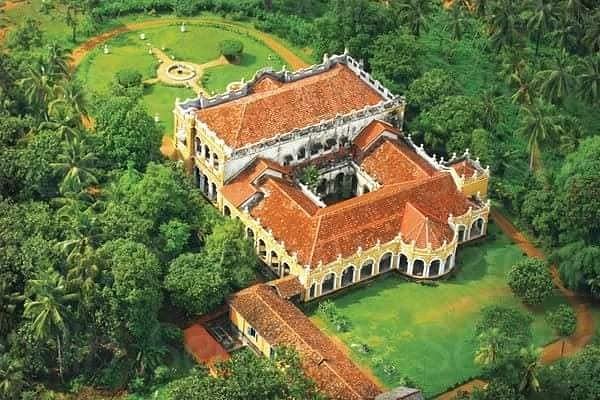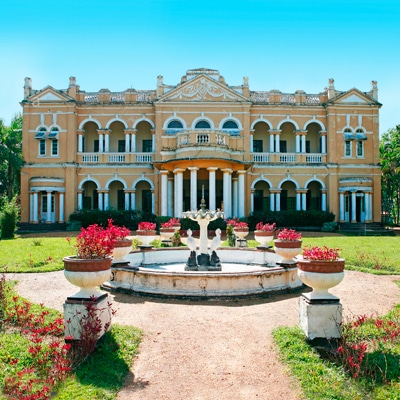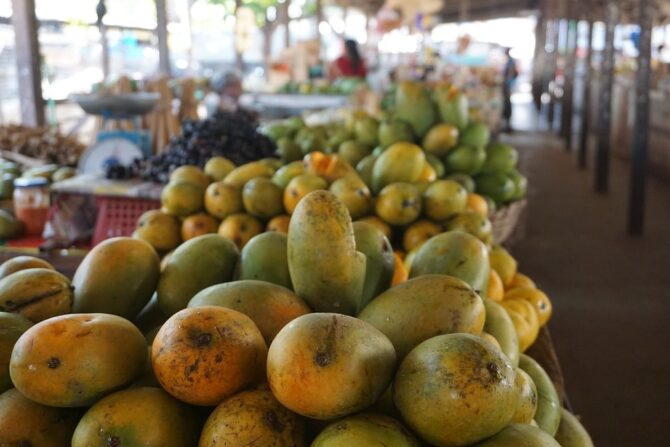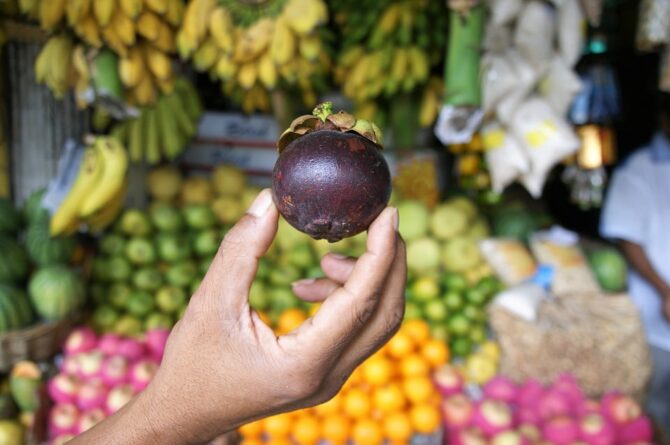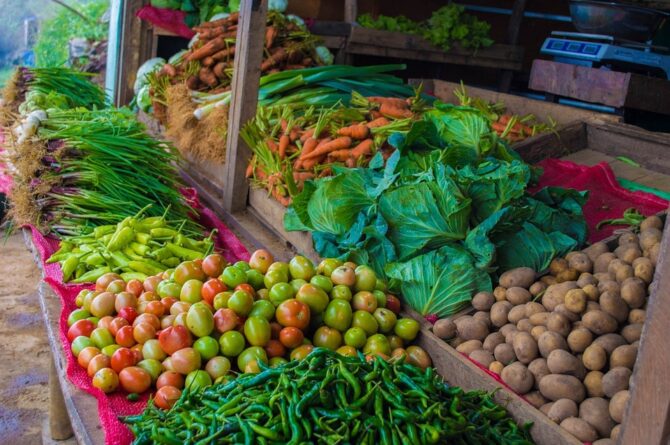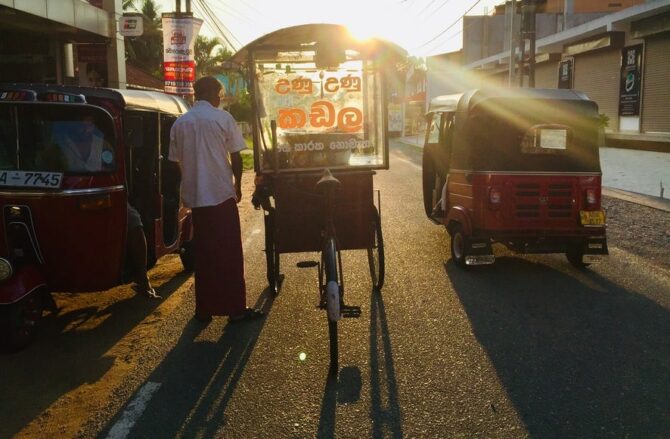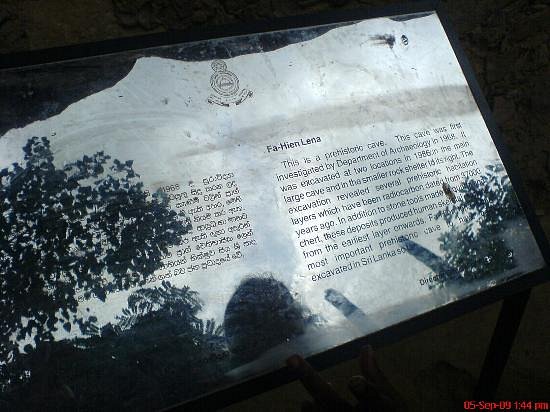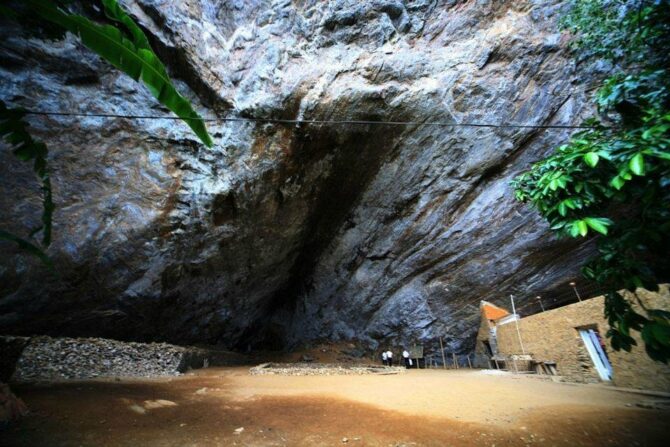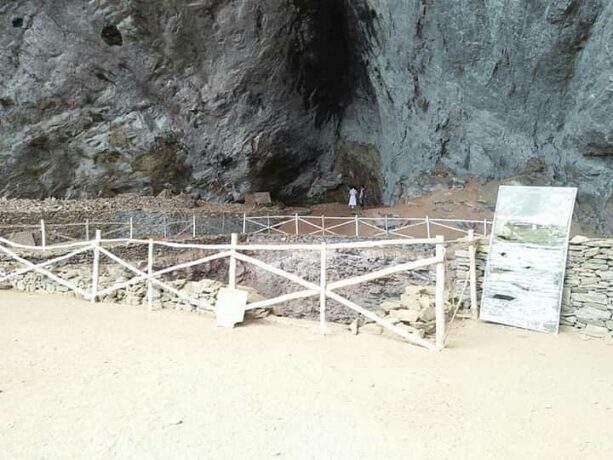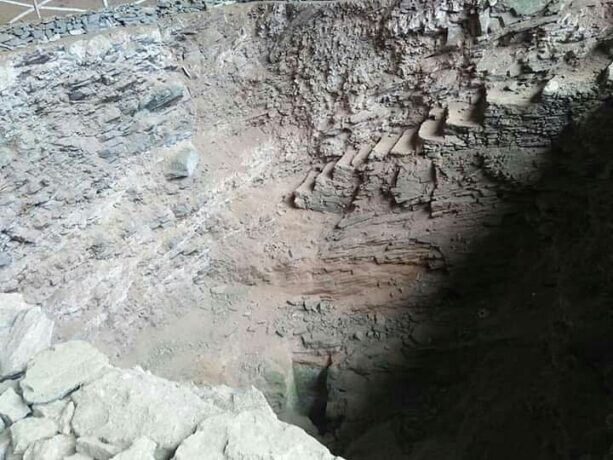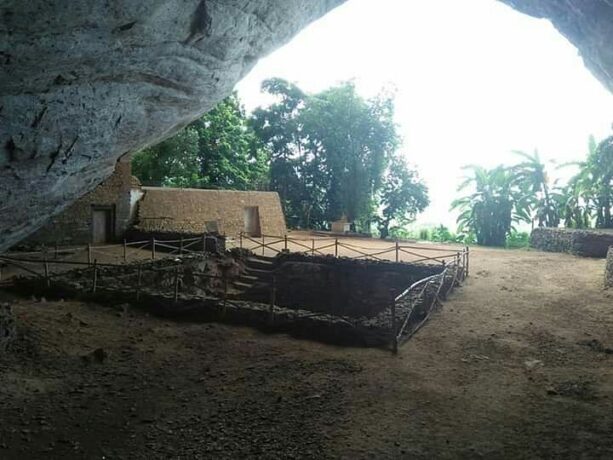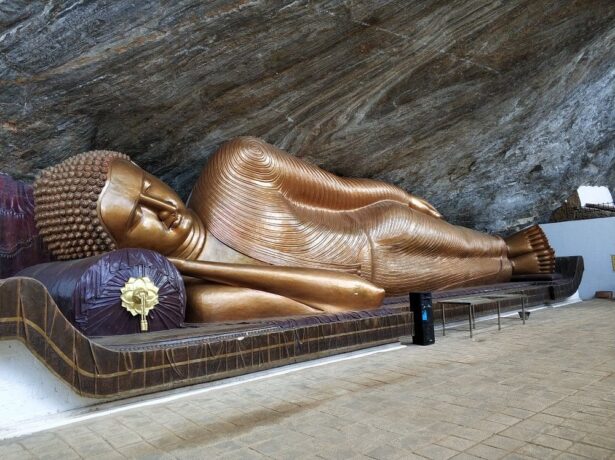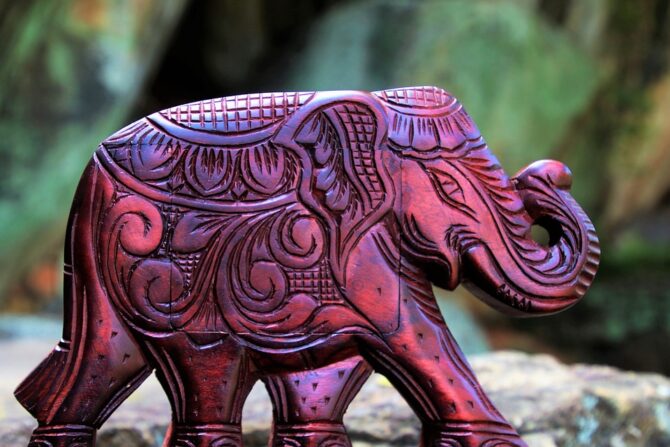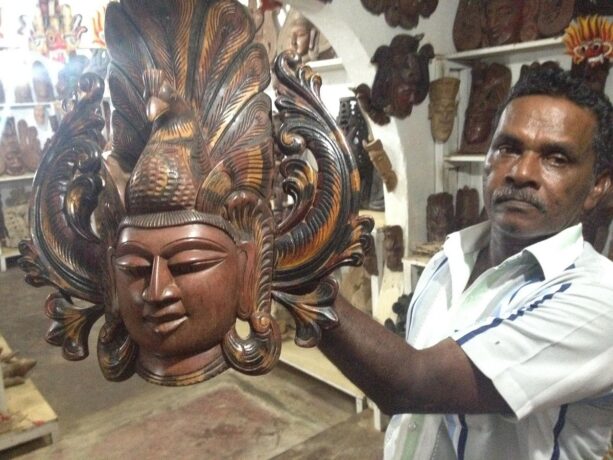Kalutara is a tourist area in the southwest of the island, known for its sports clubs. It is an ideal place for lovers of water sports: windsurfing, diving, water skiing, spearfishing and sailing. Once the city of Kalutara was also the center of the spice trade, to this day there is a smell of curry, saffron and anise in the air.
- 1 Attractions Kalutara on map
- 2 Dagoba Kalutara Vihara or Stupa Gangatilaka Vihara
- 3 Makeli Ella Waterfall
- 4 Thudugala Ella waterfall
- 5 Ratnapura – the city of precious stones
- 6 Turtle Farm in Kosgoda
- 7 Sinharaja National Park
- 8 Kalu Ganga River
- 9 Richmond Castle
- 10 Kalutara Fruit Market
- 11 Fa Hien Caves and Pahiyangala Temple
- 12 Ranjiths Carving and Batik Museum
Attractions Kalutara on map
Dagoba Kalutara Vihara or Stupa Gangatilaka Vihara
On Galle Road, not far from the bridge crossing the Kalu Ganga River, a large three-storey dagoba rises in the center of Kalutar. This is Gangatilaka Vihara, a Buddhist shrine that was built in the 1960s in the form of a hollow stupa. Inside is another dagoba, it is smaller than the first, and near it you can find several sculptures of the Buddha.
The walls of the large stupa gangatilak Vihara inside are decorated with frescoes. There are 74 of them here. All of them are devoted to the history of previous reincarnations of the Buddha. The narrow windows below these frescoes offer beautiful views of the Bentota River and the city.
The snow-white stupa of Gangatilak Vihara, which looks very impressive at night, was erected in the middle of the XX century, when the country gained independence from the British. However, the place where the dagoba was built was considered sacred before that. The fact is that directly near this stupa grows the holy tree of Buddha Kalutara Bodhiya. This tree is grown from one of thirty-two seedlings taken from the Buddha tree in Anuradhapura, which, in turn, comes from the first Bodhi tree in the Indian state of Bihar, under which the Buddha attained enlightenment.
The Bo tree was planted in the tourist area of Kalutare by a local prince who professed Hinduism, but wanted to persuade the townspeople to Buddhism. It happened in the first half of the XI century
A local landmark can also be called the bridge across the Kalu Ganga. Its length is 38 meters, and it connects the southern and western parts of the province.
The stupa of Gangatilaka Vihara (dagoba) was erected on the site of an ancient Buddhist temple. The giant white dagoba is believed to contain sacred relics belonging to the Buddha. Every day crowds of believers come to the temple who want to ask the Buddha for mercy. People meditate, make offerings, and pray silently. Tourists visit Dagoba absolutely free of charge.
Address: Sri Lanka, Kalutara Tourist Area, KT1 1AA, Galle Rd
Makeli Ella Waterfall
The Makeli Dola River, which flows through the Neluketia Nature Reserve with an area of about 1350 hectares in the Agalavatta district, becomes a beautiful waterfall in this place. Makeli Ella is one of the most beautiful waterfalls in the country and the most popular in the western province of the tourist area of Kalutara. This waterfall is created by a branch of the Makeli Oya River, which belongs to Kalu Gaga.
The 21-meter-high Makeli Ella Waterfall is the pearl not only of the tourist area of Kalutara, but of the entire country of Sri Lanka. The southwest monsoon brings heavy rainfall to this area of the waterfall, the annual amount of which is about 400 mm.
This waterfall is a hero of the Kotte era in 1500 AD. e. and is well known among the inhabitants of the country of Sri Lanka for its legends. So, for example, according to locals, the waterfall has a unique shape of the bride’s veil, when viewed from above.
Makelia Falls has a height of 20 m, and the pool at the foot of the waterfall has a depth of about 2 meters. It is easily accessible from the main road. On the way to Matugama you need to turn into Latpandura. In Latpandur, you need to go straight uphill along the Molkava road to the waterfall. The road in the direct mountainous terrain is very calm, and stretches through shady forests, where a mild climate is felt.
A platform built near Makeli Falls gives the best view of the waterfall. Getting closer to the waterfall is dangerous. If you go to see Makeli Falls, you need to be very careful.
Address: Sri Lanka, Kelinkanda, J74J+8PF
Thudugala Ella waterfall
Thudugala Ella waterfall is located in the tourist area of Kalutara in the Western Province of Sri Lanka. The estate, on which the Tudugala waterfall is located, is 400 hectares. This estate belonged to a British citizen. Today, thorny coconuts are grown on part of this estate.
The waterfall has two floors. The upper floor of the waterfall is hidden among the trees, and the lower floor is open. The water on the upper waterfall, due to its location between the trees, looks dark, but in fact it is crystal clear. You can walk to the top of the waterfall, but this part is very slippery. There are also large caves, so you need to be very careful when walking. At the entrance to the first floor of the waterfall you can see how the upper waterfall flows. Here, the pond is wider, so the waterfall looks like a stream of white foam.
Environmentalists say the waterfalls are home to several endemic species of fish, such as the sea cucumber (sandfish). And in the vicinity you can find such species of birds as the yellow heron and house sparrows. In the forest around Tudugala you can see frogs.
It is also interesting that the first small hydroelectric power plant of the country of Sri Lanka was built around this waterfall, but now it is abandoned. Today, a small hydroelectric power station looks like a dilapidated building.
Unlike the past Makeli Ella Waterfall, Thudugala Ella waterfall is a place to swim. That is why it is worth booking hotels and staying in the natural complex longer.
Ratnapura – the city of precious stones
Ratnapura is the capital of Sabaragamuwa Province in Sri Lanka. The modern name of the gemstone city comes from the Portuguese word Rapandura, meaning palm sugar traditionally produced in the area. But the most common view is that it is a combination of the words “Ratna,” meaning a gemstone, and “Pura,” meaning a city.
Located about 100 km southeast of Colombo, this gemstone city is the center of the mining industry that produces gemstones. In addition to mining, the city is also known for growing rice and fruits, large tea and rubber plantations.
Even today, the gemstones of Ratnapura are known all over the world. Rubies, sapphires and aquamarines are still mined here, and many travelers on tours to the country of Sri Lanka find semi-precious and sometimes precious stones almost on the surface. However, Ratnapura is not just a city of gems, it is also home to several important architectural landmarks for the whole country, such as the Maha Saman Deval Temple, revered by both Buddhists and Hindus. It was built on the site of an old Portuguese church.
Turtle Farm in Kosgoda
It is one of the largest turtle farms in the country. It has been in operation since 1986. Such farms began to appear in many coastal settlements and settlements of the country after the authorities urged to take care of sea turtles, not to ruin their nests and by all means to facilitate the resettlement of small turtles in the ocean.
Sea turtles, which live for about 300 years, go out on the coast of the country of Sri Lanka to dig a hole in the sand and lay eggs. There can be up to 190 eggs in a clutch. The turtle then buries the clutch and returns to the sea. Local residents and turtle farm workers dig up the eggs and take them to a protected area. For each rescued turtle egg, a citizen of the country of Sri Lanka receives a reward of 10 rupees.
After birth, turtles swim for some time in tanks with water, and then they are solemnly released into the wild, into the ocean. You can look at the young turtles, admire some of the adults who have taken root next to people, and you can visit the turtle farm in Kosgoda.
Also on the farm you can help the employees of the institution to transfer newborn turtles to the pool, take pictures with everyone’s favorite albino turtle, buy souvenirs as a souvenir of visiting the farm in a local store. And most importantly – you can see how turtles go to the beach and lay eggs. Turtles do this late at night or at night, when it is dark and there is less danger. Therefore, it is better for tourists to choose hotels nearby, where you can leave your things and relax after a sleepless night.
Address: Country Sri Lanka, Kosgoda,82MH+F4Q
Website: http://www.htrcc.info/
Sinharaja National Park
This is the most famous tropical park in the country, which is considered an important point of biodiversity. The national park was originally declared a forest reserve in 1875, followed by a biosphere reserve in 1978 and a UNESCO World Heritage Site in 1988 due to its international importance.
The vegetation of Sinharaji National Park is a tropical moist evergreen forest. Its trees are large and reach a height of 35 to 50 meters. This national park is believed to be home to nearly 50% of the country’s endemic wildlife of Sri Lanka. It attracts thousands of visitors every year who explore and experience the unique wonder of nature.
In the national park you can find:
- large mammals, such as leopards, deer, jackals and wild boars;
- small mammals: porcupine, otter and squirrel;
- predatory mammals, such as mongooses and badgers;
- some reptiles are pythons, green vipers and horned lizards;
- amphibians, these include, for example, the tree frog and the reed frog;
- more than 154 species of birds, including mixed species;
- and many others.
The length of the separate territory of the national park is about 21 km from east to west and no more than 7 km from north to south. It is a hidden treasure trove of many plants, insects, amphibians, reptiles, birds and mammals. But one of the most common mammals found in the national park is the purple-faced Langur.
Address: Country Sri Lanka, Deniyaya 81500, Sinharaja Rainforest
Website: https://www.sinharajaforestreserve.com/
Kalu Ganga River
The tourist area of Kalutara, a beautiful settlement known for two reasons. One of them is the Kalutara Bo tree, which Buddhists regularly worship and revere. The other is the beautiful Kalu Ganga Black River.
The Kalu Ganga River, referred to in ancient texts as the timeline, begins with the Samanalu of Canda (Adam’s Peak). However, there are various theories regarding the origin of the river, and some say that it originates from the Bulu Tota mountain range in the Rakwana region of Ratnapura. But one thing is for sure – this river flows into the Indian Ocean.
Along the Kalu Ganga River there are tropical gardens in which many unique tropical plants grow. In the lower reaches of the river, the estuary, ideal conditions have been created for the habitat of a large number of fish species in their natural habitat. This also includes mullet, snook, lobster and other aquatic inhabitants of the river.
Around the Black River there is a lot of entertainment for tourists. The most popular are swimming in the river and jumping through the canals.
Richmond Castle
It is one of the most iconic symbols of love. Richmond Castle, also known as the Little Taj Mahal in Sri Lanka, is located about 3 km south of the center of the kalutara tourist area.
Richmond Castle was built in 1910 by the Chief Treasurer of the Kalutara Tourist Area, Don Arthur de Silva Wijesinghe Sirivardena Mudali. He came up with the idea to build such a magnificent castle after he visited India and saw the majestic Taj Mahal Palace. Another reason for building this castle was that he wanted to surprise the family of the girl he was going to marry and win their hearts.
Most of the raw materials needed for the construction of this castle were imported, and only lime, sand and granite were used as local raw materials. The castle is made of tiles, bricks, marble, circular staircases and ceiling tiles imported from Scotland, and teak wood imported from Rangoon, Burma. The windows in the lock are made to provide natural cooling.
Downstairs and upstairs of the castle there are 14 rooms, including 5 rooms, 2 offices, a picture room and a ballroom. In addition, there is a porch, a balcony, a living room and a central courtyard. At the top of the castle there are 6 bedrooms, 4 bathrooms, a balcony and a large hall. The walls of the bedrooms of the castle are built so that the sound does not penetrate and do not come out.
A pond in the middle of the garden gives incredible beauty to this majestic castle. There are twelve marble statues whose carvings are similar to greek. The most significant composition of the castle is the statue of seven young children and a pregnant mother in the middle.
Address: Sri Lanka, Kalutara Tourist Area, JX2G+J4G
Kalutara Fruit Market
Sri Lanka is a country of exotic fruits. Here grow very tasty papaya, dragon fruit, mango, pineapple, mangosteen, carambola and other unusual fruits. All of them are worth trying, at least in small quantities. And this can be done at the local fruit market.
The fruit market of the country of Sri Lanka is a very colorful, bright and exciting sight. It is noisy, hot and crowded. It is not necessary to walk for hours through the fruit market, 15-30 minutes will be enough to enjoy the market and buy local products. At the fruit market of the country of Sri Lanka, you can find fresh tropical fruits and vegetables, buy them at home or for breakfast on a trip. Also fruit market you can find cinnamon sticks, vanilla, cashews, real black tea directly from the plantation, local sweets and much more.
Many hotels provide a free shuttle service to the fruit market on certain days. A trip to the local fruit market is also an opportunity to communicate with locals and feel the hospitality of the country of Sri Lanka. Here they can offer a free tasting of some fruit, as well as tell you where to find the best tea, souvenirs and where to go for lunch. It is very easy and pleasant to communicate with the locals, as if with old acquaintances. Well, a nice bonus: when buying, the seller will definitely give a sprig of bananas.
Fa Hien Caves and Pahiyangala Temple
In the western province of the country of Sri Lanka, there is a little-known but very interesting attraction: a cave, also called the Fa Xian Cave (399-441 AD), and the Pahiyangala Temple. A cave and a temple are named in honor of an itinerant monk who decided to follow the path of the Buddha and arrive in the country of Sri Lanka at the beginning of the V century. The monk lived in fa hien caves for several months. Later, a temple was erected on the place of his residence, next to the cave.
Pahiyangala Cave is remarkable for its size – 60 meters long and 45 meters wide, archaeological research has revealed traces of the residence of an ancient man who lived in the cave more than 35,000 years ago. According to archaeologists, the cave can accommodate more than 3 thousand people. Also during the excavations, stone tools used to hunt monkeys, deer, porcupines, food remains were found in the cave: nuts, edible snails, wild bread and more.
Many tunnels lead from the cave to nearby small caves, but at the moment they are all blocked for the safety of tourists.
According to local legend, the monk Porogama, who erected the temple in the Pahiyangala cave, used a massive two-meter piece, which is now stored at the foot of the 12-meter-high golden Buddha statue, to clear the entrance to the cave and level the ground. The same monk made alone and massive doors leading to the temple.
Pahiyangala Temple and Fa Xian Cave are sacred sites belonging to several eras. Not far from the temple and the cave is the sacred Bo tree and steps that should be bowed before climbing to the temple. Climbing the stairs, you can find many hidden statues located both inside the cave and outside. Also on the left side of this cave is Devalaya, built for the God Vishnu.
Tourists who get to these attractions, The Fa Hien Caves and the Pahiyangala Temple note that in addition to visiting the cave and the temple, you must walk to the top of the rock. To do this, you need to walk along the road on the right side of the temple. The road is made of large stones and paved with stone steps. On the way, you can see a sleeping Buddha statue facing east and about 15 meters long.
As soon as you reach the top of the cliff, a breathtaking view opens up around. Sigiriya looks especially beautiful from here. At the highest point are the ruins of an ancient dagoba.
Address: Sri Lanka, Gavaragiriya, J6X8+GGC
Ranjiths Carving and Batik Museum
The intriguing coastal tourist area of Kalutara has a lot to offer, and one place that tourists should definitely not miss is the Ranjita Carving and Batik Museum, which offers a close introduction to the traditional arts and crafts of the sri Lankan country.
This carving and batik museum simultaneously functions both as a kind of exhibition space and as a shop, allowing visitors to buy whatever they like, while also providing a platform for local artists to showcase and trade their art. The Carving and Batik Museum is one of the best places in the tourist area of Kalutare for a unique shopping experience.
Wood carving in the country of Sri Lanka has been practiced for thousands of years and is a cultural hallmark of the population. Here in the country of Sri Lanka, there are many artisans who have achieved unprecedented mastery in their art. Using materials such as sandalwood, ebony, and kadura, experienced artists create sculptures depicting animals, religious figures, and demon masks.
In the latter, according to the locals, there is a power powerful enough to scare away evil spirits. It is even believed that they are able to cure certain types of ailments and diseases.
In keeping with its name, the Museum of Carving and Batik presents an amazing range of wood and fabric products. The Ranjita Carving and Batik Museum includes more than 500 varieties of traditional Sri Lankan masks and an extensive collection of batik clothing and paintings that visitors can purchase if they like them.
The country of Sri Lanka boasts several well-known museums that have already received world rankings. And the Museum of Carving and Batik is no exception. The Museum of Wood and Batik Carvings attracts tourists all year round to showcase the country’s traditions. This museum of carvings and batik is considered one of the few most attractive places of the island state, which will always find a place on tourist routes.
It is difficult to visit so many attractions in one day, so it is better to choose hotels nearby. Hotels in the country of Sri Lanka are usually small and located right on the beach. Each is made in its own unique style, but absolutely all hotels reflect the customs and traditions of local culture and organically fit into the natural landscape.

